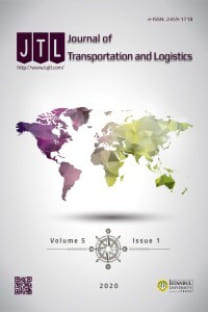Exploring the Sources of Centrality in the Turkish Domestic Airport Network
Exploring the Sources of Centrality in the Turkish Domestic Airport Network
___
- Cai, W., Wei, R., Xu, L., & Ding, X. (2021). A method for modelling greenhouse temperature using gradient boost decision tree. Information Processing in Agriculture. https://doi.org/10.1016/j.inpa.2021.08.004
- Cats, O. and Krishnakumari, P. (2020), Metropolitan rail network robustness, Physica A: Statistical Mechanics and its Applications, 549, 124317.
- Chaouk, M., Pagliari, R. and Moxon, R. (2020), The impact of national macro-environment exogenous variables on airport efficiency, Journal of Air Transport Management, 82, 101740
- Chen, Y., Wang, J. and Jin, F. (2020), Robustness of China’s air transport network from 1975 to 2017, Physica A, 539, 122876.
- Cheng, B., Ma, Y., Feng, F., Zhang, Y., Shen, J., Wang, H., Guo, Y., Cheng, Y. (2021). Influence of weather and air pollution on concentration change of PM2.5 using a generalized additive model and gradient boosting machine. Atmospheric Environment, 255, 118437. https://doi.org/10.1016/j.atmosenv.2021.118437
- Chi-Lok, A.Y. and Zhang, A. (2009), Effects of competition and policy changes on Chinese airport productivity: An empirical investigation, Journal of Air Transport Management, 15, 166–174.
- Dahiya, N., Saini, B., & Chalak, H. D. (2021). Gradient boosting-based regression modelling for estimating the time period of the irregular precast concrete structural system with cross bracing. Journal of King Saud University - Engineering Sciences. https://doi.org/10.1016/j.jksues.2021.08.004
- Dyer, A. S., Zaengle, D., Nelson, J. R., Duran, R., Wenzlick, M., Wingo, P. C., Bauer, J. R., Rose, K., Romeo, L. (2022). Applied machine learning model comparison: Predicting offshore platform integrity with gradient boosting algorithms and neural networks. Marine Structures, 83. https://doi.org/10.1016/j. marstruc.2021.103152
- Erdem, U., Tsiotas, D, and Cubukcu, K.M. (2019), Population Dynamics in Network Topology: The Case of Air Transport Network in Turkey, Management Research and Practice, 11(2), 5-20.
- Freeman, L. C. (1978). Centrality in Social Networks Conceptual Clarification. Social Networks, 1, 215–239.
- Friedman, J. H. (2001). Greedy Function Approximation: A Gradient Boosting Machine. In Source: The Annals of Statistics (Vol. 29).
- Friedman, J. H. (1999). Stochastic Gradient Boosting. Computational Statistics & Data Analysis, 38(4), 367–378. https://doi.org/10.1016/S0167-9473(01)00065-2
- Kılıç Depren, S. and Gökalp Yavuz, F. (2018), The Network Analysis of the Domestic and International Air Transportation Structure of Turkey, Mugla Journal of Science and Technology, 4(2), 148-155.
- Kosorukoff, A. (2011). Social Network Analysis: Theory and Applications. Retrieved from https://www. politaktiv.org/documents/10157/29141/SocNet_TheoryApp.pdf
- Li, N., Huang, Q., Ge, X., He, M., Cui, S., Huang, P., Li, S, and Fung, S. F. (2021), A Review of the Research Progress of Social Network Structure. Complexity, Vol. 2021. https://doi.org/10.1155/2021/6692210.
- Lin, J. (2012), Network analysis of China’s aviation system, statistical and spatial structure, Journal of Transport Geography, 22, 109-117.
- Lordan, O., Sallan, J.M., Simo, P. and Gonzalez-Prieto, D. (2014), Robustness of the air transport network, Transportation Research Part E, 68, 155–163.
- Newman, M. E. J. (2010), Networks: An Introduction. New York.
- Newman, M. E. (2008), The mathematics of networks. The New Palgrave Encyclopedia Of Economics, 2(2008), 1-12.
- Perez, C., and Germon, R. (2016), Graph Creation and Analysis for Linking Actors: Application to Social Data. In R. Layton & P. A. Watters (Eds.), Automating Open Source Intelligence. https://doi.org/10.1016/ B978-0-12-802916-9.00007-5
- Sun, X. and Wandelt, S. (2021), Robustness of Air Transportation as Complex Networks: Systematic Review of 15 Years of Research and Outlook into the Future, Sustainability, 13, 6446.
- Wandelt, S. and Sun, X. (2015), Evolution of the international air transportation country network from 2002 to 2013, Transportation Research Part E, 82, 55-78.
- Wang, J., Mo, H., Wang, F. and Jin, F. (2011), Exploring the network structure and nodal centrality of China’s air transport network: A complex network approach, Journal of Transport Geography, 19, 712-721.
- Wanke, P.F. (2013), Physical infrastructure and flight consolidation efficiency drivers in Brazilian airports: A two-stage network-DEA approach, Journal of Air Transport Management, 31, 1-5.
- Wellman, B., and Leighton, B. (1979), Networks, Neighborhoods, and Communities: Approaches to the Study of the Community Question. Urban Affairs Quarterly, 14(3), 363–390.
- Qiu, R., Liu, C., Cui, N., Gao, Y., Li, L., Wu, Z., Jiang, S., Hu, M. (2022). Generalized Extreme Gradient Boosting model for predicting daily global solar radiation for locations without historical data. Energy Conversion and Management, 258, 115488. https://doi.org/10.1016/j.enconman.2022.115488
- Ridgeway, G. (2012). gbm: Generalized Boosted Regression Models, R package version 1.6-3.2.
- Zhou, L., Fujita, H., Ding, H., & Ma, R. (2021). Credit risk modeling on data with two timestamps in peer- to-peer lending by gradient boosting. Applied Soft Computing, 110, 107672. https://doi.org/10.1016/j. asoc.2021.107672
- Yayın Aralığı: 2
- Başlangıç: 2015
- Yayıncı: İstanbul Üniversitesi
Exploring the Sources of Centrality in the Turkish Domestic Airport Network
Keziban SEÇKİN CODAL, Samet GÜNER
İsmail Fatih CEYHAN, Ferhat DEMİRCİ
Bir Hizmet Olarak Hareketlilik-MaaS Perspektifi ve Türkiye Analizi
Assessment of the municipal bus fleet electrification in Istanbul
A Method for Public Transit OD Estimation Using Transit Smart Card Data
Predicting the Time of Bus Arrival for Public Transportation by Time Series Models
Süleyman METE, Erkan ÇELİK, Muhammet GÜL
Ertuğrul AYYILDIZ, Mehmet Can ŞAHİN, Alev TAŞKIN
A Sequential Workforce Scheduling and Routing Problem for the Retail Industry: A Case Study
Uğur ELİİYİ, Onur UĞURLU, Sel ÖZCAN TATARİ
